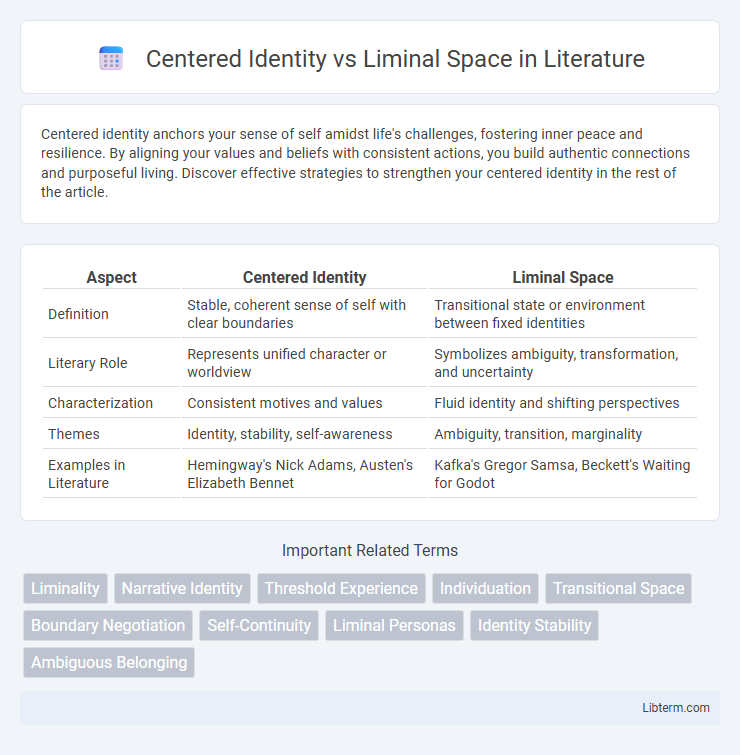Centered identity anchors your sense of self amidst life's challenges, fostering inner peace and resilience. By aligning your values and beliefs with consistent actions, you build authentic connections and purposeful living. Discover effective strategies to strengthen your centered identity in the rest of the article.
Table of Comparison
| Aspect | Centered Identity | Liminal Space |
|---|---|---|
| Definition | Stable, coherent sense of self with clear boundaries | Transitional state or environment between fixed identities |
| Literary Role | Represents unified character or worldview | Symbolizes ambiguity, transformation, and uncertainty |
| Characterization | Consistent motives and values | Fluid identity and shifting perspectives |
| Themes | Identity, stability, self-awareness | Ambiguity, transition, marginality |
| Examples in Literature | Hemingway's Nick Adams, Austen's Elizabeth Bennet | Kafka's Gregor Samsa, Beckett's Waiting for Godot |
Defining Centered Identity
Centered identity refers to a stable and coherent sense of self that anchors an individual amidst external changes and internal conflicts. It embodies a clear understanding of personal values, beliefs, and goals, providing psychological resilience and consistent behavior across different contexts. This concept contrasts with liminal space, where identity is fluid, transitional, and often marked by ambiguity and transformation.
Understanding Liminal Space
Liminal space represents the transitional phase between two distinct states, characterized by ambiguity and openness to transformation, making it a critical concept in psychology and cultural studies. Unlike centered identity, which embodies a stable and coherent self-concept, liminal space encapsulates uncertainty and potential for personal growth or change. Understanding liminal space involves recognizing its role in processes like rites of passage, identity shifts, and moments of psychological or social flux where new possibilities emerge.
Historical Contexts of Identity and Liminality
Centered identity reflects a stable, continuous sense of self rooted in historical traditions and cultural narratives that anchor individuals within specific communities across time. Liminal space represents transitional phases where established identities are suspended, often occurring during rites of passage, migration, or social upheaval, highlighting the fluidity and ambiguity of identity formation. Historical contexts such as colonialism, diasporas, and revolutions underscore the dynamic interplay between grounded identities and liminal experiences, shaping collective memory and social belonging.
Key Differences Between Centered Identity and Liminal Space
Centered identity embodies a stable and cohesive sense of self, rooted in consistent values and clear personal boundaries. Liminal space represents transitional phases or ambiguous states where identity feels fluid, uncertain, or in flux. The key difference lies in centered identity's groundedness versus liminal space's openness to transformation and ambiguity.
Psychological Implications of Centered Identity
Centered identity fosters psychological stability by providing a coherent sense of self, essential for emotional resilience and mental well-being. It reduces anxiety and confusion often experienced in liminal spaces, where ambiguity and transition challenge self-perception. Emphasizing core beliefs and values within a centered identity supports consistent decision-making and adaptive coping mechanisms.
The Role of Liminality in Personal Transformation
Liminal space represents a transitional phase where individuals experience ambiguity and uncertainty, fostering profound self-reflection and personal growth. This threshold enables a shift from a centered identity--fixed and stable--to a more fluid and evolving sense of self. Embracing liminality accelerates transformation by dissolving previous identity boundaries and encouraging new perspectives and possibilities.
Cultural Representations of Centered Identity
Cultural representations of centered identity often emphasize stability, rootedness, and a coherent sense of self anchored in tradition, community, and shared history. These portrayals highlight a strong connection to cultural norms, collective values, and enduring symbols that provide individuals with a defined place within their society. In contrast to liminal spaces, centered identity reflects continuity and belonging rather than transition or ambiguity.
Liminal Spaces in Modern Society
Liminal spaces in modern society represent transitional environments characterized by ambiguity and uncertainty, such as airports, hallways, and online forums, where traditional norms are suspended and identity exploration intensifies. These spaces facilitate personal transformation by challenging fixed identities and encouraging fluidity, creativity, and adaptation in response to social and technological changes. The pervasive presence of liminal spaces underscores contemporary culture's dynamic negotiation between stability and change, emphasizing the importance of adaptability in identity formation.
Navigating Between Centered Identity and Liminal Space
Navigating between centered identity and liminal space involves balancing a stable sense of self with the fluidity of transitional experiences. Centered identity provides grounding through consistent beliefs and values, while liminal space encourages exploration and transformation beyond established boundaries. Mastery of this dynamic allows for personal growth by integrating certainty with openness to change.
Integrating Centered Identity and Embracing Liminality
Integrating centered identity involves cultivating a stable sense of self that anchors individuals amid change, fostering resilience and clarity in decision-making. Embracing liminality requires accepting transitional, in-between states as opportunities for growth and transformation rather than periods of uncertainty or loss. Combining centered identity with liminal space encourages a dynamic balance where grounded self-awareness supports navigation through ambiguity, enhancing adaptability and personal evolution.
Centered Identity Infographic

 libterm.com
libterm.com